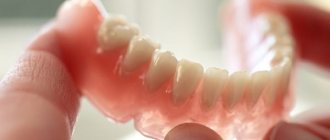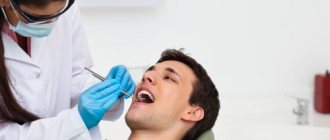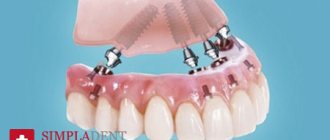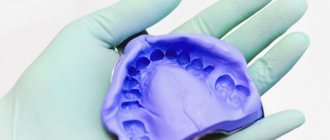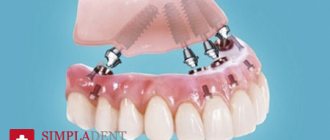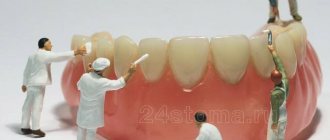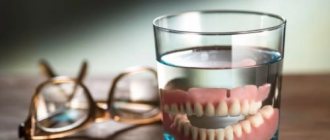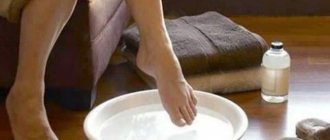Prosthetics allows you to restore the functionality and aesthetics of the dentition. After installing a fixed denture, patients experience a certain discomfort, which quickly passes, and the new teeth are quickly perceived as their own. With removable dentures, more serious problems arise, including a gag reflex and the inability to wear them every day.
Adaptation to dentures is an individual process: for some it takes only a few days, while for others it drags on for several months. We'll tell you how to quickly get used to dentures.
Dry mouth or increased salivation
A feeling of dryness or, on the contrary, increased salivation occurs due to the adaptation of the mucous membranes to a foreign body. If the design is made correctly, the discomfort quickly passes. If your mouth is dry, you should drink water more often and rinse, but do not use alcohol solutions. It is worth limiting the consumption of tea, coffee, and at least temporarily giving up smoking. You need to get rid of dryness quickly, otherwise your gums will be injured.
Excessive salivation is a reaction to a foreign body in the mouth, to constant contact with the mucous membrane. It goes away on its own in a few days. You can simplify the adaptation process for the mucous membrane by rinsing with decoctions of chamomile, oak bark or sage, or solutions recommended by your doctor.
Adaptation to dentures
On average, getting used to the prosthesis takes about 4 weeks. This period largely depends on the type of prosthesis. Thus, a plate product made of hard plastic provokes rubbing of the gums due to its rigidity and requires a long period of getting used to, up to 6 months. Acrylic and clasp dentures will require 2-3 months to get used to. Nylon constructions, quadrotti and acrifi have the shortest adaptation period of only 1-4 weeks.
The period of adaptation to the prosthesis occurs in 3 phases :
- Location phase (5 days). The prosthesis is perceived as a foreign body: it interferes with normal chewing of food and speaking. A lot of saliva is produced.
- Primary inhibition phase (5-7 days). The production of saliva is normalized, the lisp disappears, and discomfort remains when chewing food.
- Full braking phase. Discomfort is noted during removal of the prosthesis from the oral cavity.
It is possible to develop intolerance to orthodontic products with the following manifestations:
- burning, erythema in the mouth;
- soreness of the oral mucosa;
- loss of taste;
- metallic or plastic taste when eating.
This condition most often develops when there is an allergy to the materials from which the prosthesis or its components are made. This may also indicate that the prosthesis does not fit correctly.
Problems with diction
After prosthetics, there is less space in the mouth, which is why the patient may have problems with diction at first: the tongue does not have enough free space, sounds are distorted. To cope with this faster, you will need training. To do this, you can read aloud, pronounce individual complex sounds, and do tongue exercises. The more actively the tongue “works” immediately after prosthetics, the faster the adaptation will take place and normal diction will be restored. When getting used to speaking correctly, you need to make sure that when pronouncing sounds, saliva does not fly from your mouth. A good workout would be tongue twisters that are spoken slowly, making sure that the pronunciation and articulation are correct.
Talk out loud more
Without teeth, the tongue in the oral cavity is much more spacious, so after the appearance of a prosthesis in it, it becomes more difficult for a person to pronounce many sounds. To quickly restore diction:
- try to talk as much as possible, read aloud, loudly and in a whisper;
- practice pronunciation by repeatedly repeating words with sounds that are difficult for you, for example s, zh, r;
- say tongue twisters repeatedly several times a day;
- do articulatory gymnastics.
Such training will help you quickly learn to speak clearly with a removable denture.
Eating
Chewing skills with a newly installed denture need to be developed gradually. This does not mean that you need to switch to broths, purees and cereals. On the contrary, you need training with a gradual increase in load. The hardness of the products is increased gradually. It is better to start eating vegetables and fruits in small pieces, chewing them thoroughly. They get used to biting food in the same way - gradually, starting with softer foods and moving on to hard foods. You need to chew and bite carefully: it is important not to damage or injure the gums, and to control the load on it.
After installing a removable denture, the patient may feel that food is deprived of its usual taste, it has become less pronounced. This occurs because the base of the structure covers the palate where the tactile receptors are located. This does not affect the perception of taste in any way - taste buds are located on the tongue. The feeling that the taste of food has changed is associated with a foreign body in the mouth and quickly passes as you get used to it.
Do you have questions about removable dentures?
We will call you back within 30 seconds
+7
Clinical researches
Asept toothpastes and rinses are clinically proven effective. For example:
- Repeated clinical studies have proven that using ASEPTA propolis gum gel for a week can reduce gum inflammation by 31%.
- It has been clinically proven that regular use of professional toothpaste ASEPTA REMINERALIZATION after 4 weeks improved the condition of the enamel by 64% and reduced tooth sensitivity by 66%.
- Repeated clinical studies have proven that the two-component mouth rinse ASEPTA ACTIVE more effectively combats the causes of inflammation and bleeding compared to single-component rinses - it reduces inflammation by 41% and reduces bleeding gums by 43%.
Sources:
- The effectiveness of the use of Asept “adhesive balm” and Asept “gel with propolis” in the treatment of chronic generalized periodontitis and gingivitis in the acute stage (Municipal Dental Clinic No. 4, Bryansk, Kaminskaya T. M. Head of the therapeutic department Kaminskaya Tatyana Mikhailovna MUZ City Dental Clinic No. 4, Bryansk
- Report on the determination/confirmation of the preventive properties of personal oral hygiene products “ASEPTA PLUS” Remineralization doctor-researcher A.A. Leontyev, head Department of Preventive Dentistry, Doctor of Medical Sciences, Professor S.B. Ulitovsky First St. Petersburg State Medical University named after. acad. I.P. Pavlova, Department of Preventive Dentistry
- The role of anti-inflammatory rinse in the treatment of periodontal diseases (L.Yu. Orekhova, A.A. Leontyev, S.B. Ulitovsky) L.Yu. OREKHOVA, Doctor of Medical Sciences, Prof., Head of Department; A.A. LEONTIEV, dentist; S.B. ULITOVSKY, Doctor of Medical Sciences, Prof. Department of Therapeutic Dentistry of St. Petersburg State Medical University named after. acad. I. P. Pavlova
Injuries
In the first days after installation, injured areas may appear on the surface of the gums: small wounds, abrasions, etc. They may appear due to improper chewing technique or sensitivity of the mucous membrane. Normally, the denture stops rubbing the gums within a few days. You can speed up this process by rinsing with antiseptic solutions and chamomile decoction.
If injuries do not go away over time, become more pronounced, or cause increasing discomfort, you should consult a doctor. The problem may lie in the design itself. The doctor will conduct an examination and correct the prosthesis. Usually one correction is enough for the discomfort to go away.
How to fix the situation
If the removable denture does not stay in place, you need to make an appointment with an orthopedist. You cannot adjust dentures yourself. It can be so damaged that it cannot be repaired. In addition, in the absence of special tools and skills, it is possible to create a traumatic edge and provoke prosthetic stomatitis.
The doctor will correct, adjust or reline the structure and the problem will most likely be solved.
Sometimes, the patient cannot get used to the restoration or, due to anatomical features, the denture falls off and no measures help. In such cases, implant prosthetics are recommended.
Implantation is the implantation of titanium rods into the bone tissue, which act as a tooth root. The prosthetic structure is then attached to them. This can be either a single crown or a full jaw restoration. This type of prosthetics will allow you to forget about the loss of an artificial jaw. Implantation stops bone tissue atrophy and restores normal chewing function.
An example of dental prosthetics on implants
Caring for fixed structures is easier, they are attached better and creams and gels are no longer needed. It is enough to brush them like regular teeth and undergo a preventive examination.
Allergic reaction
It occurs very rarely, since all structural elements are made of hypoallergenic, biocompatible materials. It manifests itself as redness of the gums at the contact site; this area may itch and possibly burn. The unpleasant sensations do not go away and do not weaken, they can intensify, the gums look injured.
Allergy is a rejection of construction materials, which may be accompanied by nausea, malaise, and dizziness. It appears almost immediately after installation, disappears after some time if you remove it. There is no point in waiting for adaptation in case of allergies - the reaction will only intensify over time. To solve the problem, you need to find out which material in the structure you are allergic to and make a new prosthesis without using it.
Options for getting out of the current situation
The problem is resolved on an individual basis, taking into account the client’s personal wishes and financial capabilities. Corrective methods include: relining the structure, replacing components, implanting dentures, manufacturing a more advanced structure. Magnetic fixation, adjustment or replacement of fixation mechanisms are also often used.
An important point is that after 3-5 years, even the most expensive products need replacement or adjustment. Timely replacement is the right solution for those who want to have a wonderful smile without huge financial costs.
Recommendations for use
| Click to sign up for a FREE consultation |
The service life of each product directly depends on the source materials, operating conditions and variety. Thus, the service life of an acrylic structure is about 5 years, clasp systems - up to 10 years.
An important aspect is the storage of the prosthesis. It is recommended to store rubber products in water at night, as this prevents their deformation; more modern acrylic and nylon prostheses do not need to be removed at all (if you want to take a break from the prosthesis, the structure can be removed, cleaned and placed in a special case). If you have not worn a removable denture for a long time, it should be treated with an antiseptic before installation.
The main rule for long-term use of a removable denture is regular visits to the doctor. Don't forget to visit the dentist at least once a year.
Psychological aspect
Often the use of a prosthesis provokes psychological discomfort in the patient: it frightens him, it seems to him that complications have already arisen, and adaptation is not going well. To prevent such a problem from arising, you need the right attitude: a person must be prepared for the difficulties that may arise in the first days. It is important to take your time and understand that the body needs to get used to new conditions. The period of complete adaptation takes up to one and a half months on average, but the most noticeable discomfort disappears after 1-2 weeks if you wear the prosthesis constantly.
To get used to a removable denture faster, orthodontists at the Dentospas clinic recommend massaging the gums. You can do it yourself, it will improve blood circulation and tissue nutrition, and improve the condition of the gums. Massage is done provided that the surface of the mucous membrane is not injured and there are no open wounds on it. At first, to speed up adaptation, you can leave the prosthesis on at night (install it again after cleaning). This is safe (the gums and tongue hardly move during sleep) and allows you to increase the time of contact of the mucous membrane with the base of the structure.
Possible consequences
The longer a patient uses a prosthesis characterized by an unstable position, the more serious the consequences for his health may be. Potential complications include:
- Constant physical and psychological discomfort associated with displacement of the structure while eating or communicating with others;
- Damage to the oral mucosa caused by rubbing or biting;
- Impaired diction, as well as distortion of natural facial proportions;
- Regular entry of food particles into the area between the prosthesis and the base, which results not only in the formation of pathogenic microflora, but also in disorder of the digestive system;
- Possibility of failure of the replacement structure;
- The need for constant adjustment of the position of the removable denture.
In such a condition, it is difficult to talk about restoring the aesthetics and functionality of the jaw, therefore, at the first signs of a fixation disorder, it is recommended to contact your dentist.
